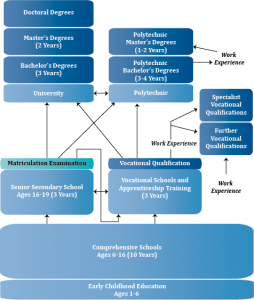From an Education Week blog:
Student Tracking vs. Academic Pathways: Different…or the Same?
By Marc Tucker on October 15, 2015 6:25 AM
…
The most insidious aspect of the sorting—or tracking—system is the way it results in teachers making judgments about the innate ability of students and then adjusting the challenge of the curriculum they get to the judgment they made. This inevitably leads to self-fulfilling prophecies.
There is only one antidote to the sorting mentality—new or old—and its insidious consequences. That is to stop adjusting the challenge level of the curriculum down to the presumed ability of the students. It is to set high standards for all students, not just some, and then to do whatever is necessary to get the students to those standards. That sounds impossibly naïve, but it is just what the top-performing countries do. Judging from their results, it works.
Eduhonesty: Oh, please, help us somebody! Yes, I’d call that demand for high standards for all students naïve. It’s also not what top-performing countries do, not exactly. Yes, they set high standards and expectations, as we should. But they also sort students. Finland sorts students into vocational as opposed to college tracks. In high school, students enter one track or the other in a nearly even split. The following graph shows Finnish options. http://www.ncee.org/programs-affiliates/center-on-international-education-benchmarking/top-performing-countries/finland-overview/finland-instructional-systems/

I had a long conversation a few years ago with a young woman on a train in Germany about the German educational system. After completing their primary education (at 10 years of age, 12 in Berlin and Brandenburg), children attend one of five types of secondary schools in Germany. The five kinds of schools vary from state to state in Germany. Essentially, students have a vocational option, a college-track option, and schools that offer elements of both.
South Korea does not do vocational tracking, but instead follows the exhortation above to set “high standards for all students, not just some, and then to do whatever is necessary to get the students to those standards.”
In “An Assault Upon Our Children: South Korea’s Education System Hurts Students,” by SE-WOONG KOO, AUG. 1, 2014, Koo talks about the South Korean educational system and the chest pains and allergies his brother suffered from the stress of being a student in South Korea. Mom moved Koo out of the country to Vancouver because of that stress. To quote a paragraph from that article:
“The world may look to South Korea as a model for education — its students rank among the best on international education tests — but the system’s dark side casts a long shadow. Dominated by Tiger Moms, cram schools and highly authoritarian teachers, South Korean education produces ranks of overachieving students who pay a stiff price in health and happiness. The entire program amounts to child abuse. It should be reformed and restructured without delay.”
I strongly recommend the rest of the article at http://www.nytimes.com/2014/08/02/opinion/sunday/south-koreas-education-system-hurts-students.html?_r=0
Eduhonesty: Articles like “Student Tracking vs. Academic Pathways: Different…or the Same?” make me want to toss up my hands and write science fiction. I am hanging in here only because I have watched children paying the price for all this idealistic propaganda. I feel the need to try to rescue those children. I am also offended by the presumptuousness behind some of that idealism. The world needs as many plumbers as philosophers. In fact, in terms of job openings, I’d far rather be a plumber than a philosopher. If I opened my own business, I’d almost certainly make more money repairing toilets and faucets than the average philosopher makes. I’m pretty sure my plumber makes more in a year than I ever have as a teacher. I wouldn’t be surprised to discover he makes twice as much.
In the meantime, this country has racked up $1.2 trillion in college-loan debt. In many cases, students did not finish and get a degree, but they remain saddled with those loans, albatrosses tied around their necks for possible decades. Too often, counselors and other responsible adults knew or should have known that those debt-laden students had little chance of college success, but said nothing. That truth was left off the agenda, a victim of the social agenda of college-for-all.
Our students are real people, not items in a social agenda. Instead of telling them they must go to college, we ought to create alternative options for those who don’t like school and/or who have trouble with the “rigorous” material that now sometimes has become our only offering. What do we have to offer to students who can’t follow the complex questions favored by the Common Core? They exist. The PARCC and Smarter Balance test results amply demonstrate that they exist.
I acknowledge we can’t unleash large hordes of electricians on the world, but community colleges offer many programs that could be taken in high school. I have a former student who is paying a technical school $13,000 to become a medical assistant right now. Why don’t we offer that option in high school? Many one- and two-year programs could be spread out over the four years of high school. Why don’t we offer automotive repair, CAD/CAM classes, graphic design and practical nursing to interested students? Why not allow students to study to become dental hygienists? My students spend so much money to go to culinary school and beauty school after high school – and we leave them no choice. In many cases, they know what they want to do by the time they are sixteen or even younger. They then go straight to trade school or the community college specifically to get a degree or certificate that their high school could have offered them sooner for free.
The idea that working harder will somehow result in a universe where everyone can pass the annual state standardized test and go to college seems to be the pipe dream propelling our government’s agenda. If that pipe dream were true, No Child Left Behind might have succeeded. The government set up Draconian penalties for failing to make targets and then told the schools to make NCLB work. Yet NCLB never worked. Many of the best schools in the country ended up on watch and warning lists, while curriculums were gutted, recesses were eliminated, and cheating skyrocketed.
I’d like to ask the people making today’s educational policy to come down off Mount Olympus and talk to some of the students in our middle schools and high schools — and not just the middle schools and high schools in their own middle class and upper class neighborhoods. Come on down, guys. Meet America’s students. Find out who they are. Ask them what they want. Ask them how we can help them to achieve their dreams, with the understanding that wanting to cut and color hair should be considered a perfectly acceptable answer.
That girl who wants to go to beauty school? The odds are excellent that she will do exactly that. She does not need to hear that she is making a mistake and should go to college to study chemistry instead. When we don’t create alternative high school pathways, but insist that students stay on the one-and-only-one true path, the college path, we devalue that girl’s interests and choices. We may or may not change her mind about going to beauty school. But if we don’t, our words and their implicit criticism may succeed in making that girl feel like an underperforming, second-class citizen for the rest of her life.
We have to present our students with all their options. We have to offer them the possibility of college and university success when possible. I’ve had many students who remained completely uninterested in college after the many years of being pushed in that direction, though. I’ve had students who already knew they intended to join dad’s landscaping business. I’ve had students who did not read or who could not read and who simply were not going to succeed unless they had a personal epiphany. Without that epiphany, those students had no business taking out student loans.
Maybe we need to take a hard look at the Finnish model. After a decade of NCLB, the learning landscape does not seem to have radically improved. We still have many students who are unready for college, academically and/or emotionally. So I am going to end by disagreeing with Marc.
Call it tracking. Call it pathways. Call it whatever acronym you want to invent for it. I believe we ought to provide real vocational tracks to our students. I’d wait until high school. But if a sixteen-year-old girl wants to study auto repair at the expense of the college curriculum, I’d say let her go for it. Let her graduate with a skill she can turn into a job.
If she changes her mind later, she can fill in her educational gaps at a community college. Community colleges have become fully expert at remedial education. Many young Americans have gone back to school in their twenties and gone on get advanced degrees.
Opening practical, vocational pathways should not be considered closing doors. For many students, these pathways will open doors. My former student could easily have learned to be a medical assistant in high school. As it stands, she will owe $13,000, a debt I don’t believe she should ever have had to incur.




